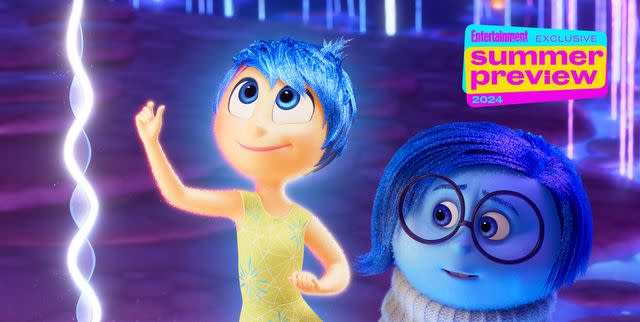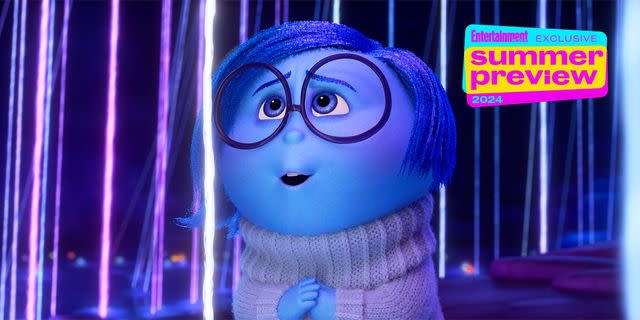Welcome to the Belief System, a core part of Riley's mind in “Inside Out 2”

Get your first look at this key new area of Riley's brain.
EW's 2024 Summer Preview has dozens of exclusive looks at the most anticipated TV shows, movies, books, and music of entertainment's hottest season. Continue to visit ew.com throughout May for more previews of what you'll be watching, reading, and listening to in the months to come.
What do you believe?
That's a key question at the heart (or we suppose, technically, brain) of Inside Out 2. While Inside Out anthropomorphized our emotions and memories, its sequel will take audiences even further into the recesses of the mind — visualizing our belief system.
The sequel (in theaters June 14) is a follow-up to 2015’s Oscar-winning Pixar film, which took audiences inside the mind of tween girl, Riley (Kaitlyn Dias), as her core emotions — Joy (Amy Poehler), Sadness (Phyllis Smith), Anger (Lewis Black), Fear (Bill Hader), and Disgust (Mindy Kaling) — helped her navigate a destabilizing cross-country move. (Tony Hale now voices Fear and Liza Lapira voices Disgust in the new movie.)
Inside Out 2 brings us an older, though not wiser, Riley (Kensington Tallman) at 13 years old, who is suddenly overtaken by a series of new emotions — Anxiety (Maya Hawke), Ennui (Adèle Exarchopoulos), Envy (Ayo Edebiri), and Embarrassment (Paul Walter Hauser) — as she undergoes puberty. When Anxiety takes over her brain, Joy and the others must figure out how to help Riley restabilize emotionally. But it’s not merely new emotions this go-round; we’ll also visit Riley’s Belief System.

Disney/Pixar
Amy Poehler voices Joy and Phyllis Smith voices Sadness in 'Inside Out 2'“The sequel to Inside Out is still going to be set in Riley's mind,” screenwriter Dave Holstein tells Entertainment Weekly of the new addition. “You have this promise to the audience to expand that world and to go deeper. You can't go different.”
In the images of the Belief System, which EW can exclusively debut, the beliefs appear as cords of light that fluctuate and resemble sound waves. Holstein first got the idea for the concept from unused art from the first film: “It was a very basic version of what's in there now — the strings that grow from memories.”
“The Inside Out world is so cool because you can take these abstract elements that we all know about the brain and you can physicalize them,” director Kelsey Mann adds. “They did that so beautifully with memories in the first film. We started thinking about teenagers and how you start to become your own person. You start to develop your own set of beliefs.”
“It felt like the first movie was about memories, and there was something quite emotional for me in finding a way to show beliefs as we get older," Holstein continues. "Our beliefs certainly solidify as we get older. Maybe we hadn't seen them before, not because they didn't exist, but because now is a time when beliefs start to become of a different level of importance to you.”

Disney/Pixar
Phyllis Smith as Sadness in 'Inside Out 2'Mann explains that because it can be difficult to visualize something like a belief, the filmmakers arrived at the idea of making the beliefs something we could hear. That, in turn, led to the animators’ refining their design. “You've got those voices in your head that are good and bad," he says. "Then somebody had the idea of waveforms and plucking a string, like a guitar string. That started to give us a visual language for it.”
Holstein envisioned the Belief System as a near-sacred space; "the holy of holies,” he describes. “It felt very temple-like being in a space where you could listen to the things that Riley believed in. To hear them expressed instrumentally with Riley's voice was a very emotionally impactful thing," he says. "There are not really any times when Joy can speak to Riley, and it created this opportunity where Joy and Riley could talk in a way that felt very beautiful and unexplored.”
It’s not all moral codes and a sense of good and evil either. The Belief System has plenty of silly aspects, too. Holstein points out, “They could be things like, ‘I believe dad's beard will never go away.’ There's things that you believe with the intensity of a thousand stars at that age that don't necessarily have to be very serious. There are lots of things I believed at that age that I'm sure were not even true, but that certainly guided my day-to-day emotional world.”
Giving audiences, especially younger ones, a toolbox to navigate their overwhelming emotions and beliefs is what the Inside Out films are all about (and, you know, telling an engaging story). Mann hopes that Inside Out 2 will expand on the first film, providing empathy and a toolbox for what is often the most challenging time of a person’s life — their teen years.
“The first film gave everyone a visual language to talk about their feelings,” he reflects. “I thought, ‘If I can do that for teenagers' — which was probably the hardest time in my life — 'and if I can make that time a little better, then I'd love to.'"
Want more movie news? Sign up for Entertainment Weekly's free newsletter to get the latest trailers, celebrity interviews, film reviews, and more.
Related content:
Meet Riley's new turtleneck-sporting emotion — voiced by Maya Hawke! — in the Inside Out 2 trailer
See all the stars who swung by EW's CinemaCon 2024 portrait studio
Read the original article on Entertainment Weekly.

 Yahoo News
Yahoo News 
